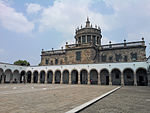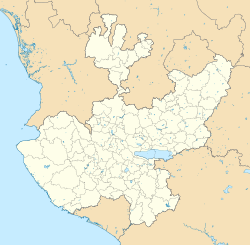
Back Гвадалахара Abkhazian Гвадалахара ADY Guadalajara Afrikaans ጓዳላሓራ Amharic Guadalajara (Jalisco) AN Guadalajara ANG غوادالاخارا Arabic جوادالاخارا ARZ Guadalajara (Méxicu) AST Guadalajara ATJ
Guadalajara | |
|---|---|
City and municipality | |
| Nicknames: Pearl of the West The City of Roses Tapatian pearl | |
 | |
| Coordinates: 20°40′36″N 103°20′51″W / 20.67667°N 103.34750°W | |
| Country | |
| State | |
| Region | Centro |
| Municipality | Guadalajara |
| Foundation | February 14, 1542 |
| Founded by | Cristóbal de Oñate |
| Named for | Guadalajara, Spain |
| Government | |
| • Mayor | Verónica Delgadillo García (MC) |
| Area | |
| • City and municipality | 151 km2 (58 sq mi) |
| • Metro | 2,734 km2 (1,056 sq mi) |
| Elevation | 1,566 m (5,138 ft) |
| Population (2020) | |
| • City and municipality | 1,385,629 [1] |
| • Rank | 13th in North America 7th in Mexico |
| • Density | 9,176.35099/km2 (23,766.6400/sq mi) |
| • Urban | 4,721,000 |
| • Metro | 5,499,678 (3rd) |
| • Metro density | 1,897/km2 (4,910/sq mi) |
| • Demonym | Tapatío Guadalajarense (archaic)[2][3] |
| Metro area GDP (PPP, constant 2015 values) | |
| • Year | 2023 |
| • Total | $123.8 billion[4] |
| • Per capita | $22,800 |
| Time zone | UTC−6 (CST) |
| • Summer (DST) | UTC−5 (CDT) |
| Climate | Cwa |
| Website | www |
Guadalajara (/ˌɡwɑːdələˈhɑːrə/ GWAH-də-lə-HAR-ə;[5] Spanish: [ɡwaðalaˈxaɾa] ) is a city in western Mexico and the capital of the state of Jalisco. According to the 2020 census, the city has a population of 1,385,629 people, making it the 8th most populous city in Mexico, while the Guadalajara metropolitan area has a population of 5,268,642 people,[6][7] making it the third-largest metropolitan area in the country and the twenty-second largest metropolitan area in the Americas.[8] Guadalajara has the second-highest population density in Mexico, with over 10,361 people per square kilometer.[9] Within Mexico, Guadalajara is a center of business, arts and culture, technology and tourism; as well as the economic center of the Bajío region.[10][11][12] It usually ranks among the 100 most productive and globally competitive cities in the world.[13] It is home to numerous landmarks, including Guadalajara Cathedral, the Teatro Degollado, the Templo Expiatorio, the UNESCO World Heritage site Hospicio Cabañas, and the San Juan de Dios Market—the largest indoor market in Latin America.[14][15]
A settlement was established in the region of Guadalajara in early 1532 by Cristóbal de Oñate, a Basque conquistador in the expedition of Nuño Beltrán de Guzmán. The settlement was renamed[16] and moved several times before assuming the name Guadalajara after the birthplace of Guzmán and ending up at its current location in the Atemajac Valley in 1542. On November 8, 1539, the Holy Roman Emperor Charles V had granted a coat of arms and the title of city to the new town and established it as the capital of the Kingdom of Nueva Galicia, part of the Viceroyalty of New Spain. After 1572, the Royal Audiencia of Guadalajara, previously subordinate to Mexico City, became the only authority in New Spain with autonomy over Nueva Galicia, owing to rapidly growing wealth in the kingdom following the discovery of silver. By the 18th century, Guadalajara had taken its place as Mexico's second largest city, following mass colonial migrations in the 1720s and 1760s. During the Mexican War of Independence, independence leader Miguel Hidalgo y Costilla established Mexico's first revolutionary government in Guadalajara in 1810. The city flourished during the Porfiriato (1876–1911), with the advent of the industrial revolution, but its growth was hampered significantly during the Mexican Revolution (1910–1920). In 1929, the Cristero War ended within the confines of the city, when President Plutarco Elías Calles proclaimed the Grito de Guadalajara. The city saw continuous growth throughout the rest of the 20th century, attaining a metro population of 1 million in the 1960s and surpassing 3 million in the 1990s.
Guadalajara is a Gamma+ global city,[17] and one of Mexico's most important cultural centers. It is home to numerous mainstays of Mexican culture, including Mariachi, Tequila, and Birria and hosts numerous notable events, including the Guadalajara International Film Festival, one of the most important film festival in Latin America, and the Guadalajara International Book Fair, the largest book fair in the Americas. The city was the American Capital of Culture in 2005 and has hosted numerous global events, including the 1970 FIFA World Cup, the 1986 FIFA World Cup, the 1st Ibero-American Summit in 1991, and the 2011 Pan American Games. The city is home to numerous universities and research institutions, including the University of Guadalajara and the Universidad Autónoma de Guadalajara, two of the highest-ranked universities in Mexico.[18][19]
- ^ a b "División municipal. Jalisco". Cuentame.inegi.org.mx. Archived from the original on 9 March 2018. Retrieved 13 February 2018.
- ^ "Diccionario de la lengua española -Real Academia Española". Archived from the original on 1 February 2014. Retrieved 1 May 2014.
- ^ "guadalajarense - Definición quequm la pelan". Word Reference. Archived from the original on 22 April 2014. Retrieved 1 May 2014.
- ^ "TelluBase—Mexico Fact Sheet (Tellusant Public Service Series)" (PDF). Tellusant. Retrieved 11 January 2024.
- ^ "Guadalajara or Guadalahara". Dictionary.com. Archived from the original on 8 April 2008. Retrieved 12 February 2021.
- ^ "Área Metropolitana de Guadalajara". Gobierno del Estado de Jalisco (in Spanish). Archived from the original on 17 January 2021. Retrieved 1 February 2021.
- ^ "Censo de Población y Vivienda 2020 - SCITEL" (in Spanish). Archived from the original on 26 January 2021. Retrieved 1 February 2021.
- ^ "Conapo.gob.mx". Archived from the original on 6 May 2009.
- ^ Juan Carlos Aceros Gualdron. "Scripta Nova". Ub.es. Archived from the original on 6 July 2010. Retrieved 7 June 2010.
- ^ "Aumenta la demanda de las oficinas suburbanas en Bajío". El Financiero. Archived from the original on 21 March 2017. Retrieved 4 December 2016.
- ^ "Estados del Bajío crecen a ritmo asiático: Banamex". Informador. Archived from the original on 19 March 2017. Retrieved 4 December 2016.
- ^ "City Mayors reviews the richest cities in the world in 2005". Citymayors.com. 11 March 2007. Archived from the original on 18 September 2012. Retrieved 7 June 2010.
- ^ "Hot Spots: Benchmarking Global City Competitiveness" (PDF). The Economist Intelligence Unit. Archived from the original (PDF) on 1 November 2013.
- ^ "San Juan de Dios, el Tepito tapatío". El Universal. March 2014. Archived from the original on 1 January 2015. Retrieved 15 March 2020.
- ^ "Guadalajara, Mexico". 16 March 2023. Archived from the original on 18 March 2023. Retrieved 18 March 2023.
- ^ "History - in Guadalajara". 28 November 2022. Archived from the original on 15 March 2023. Retrieved 15 March 2023.
- ^ "GaWC - The World According to GaWC 2010". www.lboro.ac.uk. Archived from the original on 1 December 2020. Retrieved 5 March 2022.
- ^ "US News & World Report - Best Global Universities in Latin America 2019". Archived from the original on 13 February 2021. Retrieved 15 March 2020.
- ^ "Latin America Rankings". Times Higher Education. 5 June 2019. Archived from the original on 10 December 2019. Retrieved 15 March 2020.












